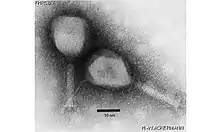Tevenvirinae
Tevenvirinae is a subfamily of viruses in the order Caudovirales, in the family Myoviridae. Bacteria and archaea serve as natural hosts. There are currently 77 species in this subfamily, most included in 11 genera.[1][2]
| Tevenvirinae | |
|---|---|
 | |
| Electron micrograph of two virions of genus Tequatrovirus | |
| Virus classification | |
| (unranked): | Virus |
| Realm: | Duplodnaviria |
| Kingdom: | Heunggongvirae |
| Phylum: | Uroviricota |
| Class: | Caudoviricetes |
| Order: | Caudovirales |
| Family: | Myoviridae |
| Subfamily: | Tevenvirinae |
| Genera | |
|
see text | |
Taxonomy
The following genera are recognized:[2]
- Dhakavirus
- Gaprivervirus
- Gelderlandvirus
- Jiaodavirus
- Karamvirus
- Krischvirus
- Moonvirus
- Mosigvirus
- Schizotequatrovirus
- Slopekvirus
- Tequatrovirus
The following species are unassigned to a genus:[2]
- Acinetobacter virus 133
- Aeromonas virus 65
- Aeromonas virus Aeh1
- Escherichia virus RB16
- Escherichia virus RB32
- Escherichia virus RB43
- Pseudomonas virus 42
Structure

Viruses in Tevenvirinae are non-enveloped, with head-tail geometries. These viruses are about 70 nm wide and 140 nm long. Genomes are linear, around 170-245kb in length. The genome codes for 300 to 415 proteins.[1]
Life cycle
Viral replication is cytoplasmic. Entry into the host cell is achieved by adsorption into the host cell. DNA-templated transcription is the method of transcription. The virus exits the host cell by lysis, and holin/endolysin/spanin proteins. Bacteria and archaea serve as the natural host. Transmission routes are passive diffusion.[1]
References
- "Viral Zone". ExPASy. Retrieved 1 July 2015.
- "Virus Taxonomy: 2019 Release". talk.ictvonline.org. International Committee on Taxonomy of Viruses. Retrieved 2 May 2020.